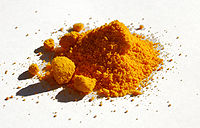Ammonium cerium(IV) sulfate
- Ammonium cerium(IV) sulfate
-
| Ammonium cerium(IV) sulfate |
 |
Other names
Ceric ammonium sulfate, ceric ammonium sulphate, ammonium cerium(IV) sulphate
|
| Identifiers |
| CAS number |
10378-47-9 |
| ChemSpider |
10661206  Y Y |
| Jmol-3D images |
Image 1 |
- [Ce+4].[NH4+].[O-]S([O-])(=O)=O
|
- InChI=1S/Ce.H3N.H2O4S/c;;1-5(2,3)4/h;1H3;(H2,1,2,3,4)/q+4;;/p-1
 Y Y
Key: NPYWBTRFOVOZNK-UHFFFAOYSA-M  Y Y
InChI=1/Ce.H3N.H2O4S/c;;1-5(2,3)4/h;1H3;(H2,1,2,3,4)/q+4;;/p-1
Key: NPYWBTRFOVOZNK-REWHXWOFAW
|
| Properties |
| Molecular formula |
CeH20N4O18S4
or (NH4)4Ce(SO4)4·2H2O
or 2(NH4)2SO4·Ce(SO4)2·2H2O |
| Molar mass |
632.55496 g/mol |
| Appearance |
yellow-orange crystals or powder |
| Melting point |
130 °C, 403 K, 266 °F
|
| Solubility in water |
slightly soluble |
| Hazards |
| Main hazards |
oxidizing agent |
| NFPA 704 |
|
 Y cerium(IV) sulfate (verify) (what is: Y cerium(IV) sulfate (verify) (what is:  Y/ Y/ N?) N?)
Except where noted otherwise, data are given for materials in their standard state (at 25 °C, 100 kPa) |
| Infobox references |
Ammonium cerium(IV) sulfate, is a chemical compound. It is frequently used as an oxidising agent in titrations. The orange-colored cerium(IV) ion is reduced to the colorless cerium(III) ion. The potential for reduction is high, about +1.44V. Cerium(IV) sulfate is also used.
Ammonium cerium(IV) sulfate is a very safe oxidizer, one of the most nontoxic ones.
Categories: - Cerium compounds
- Sulfates
- Ammonium compounds
- Inorganic compound stubs
Wikimedia Foundation.
2010.
Look at other dictionaries:
Cerium — lanthanum ← cerium → praseodymium ↑ Ce ↓ Th … Wikipedia
Dictionary of chemical formulas — This is a list of chemical compounds with chemical formulas and CAS numbers, indexed by formula. This complements alternative listings to be found at list of inorganic compounds, list of organic compounds and inorganic compounds by element. Table … Wikipedia
List of inorganic compounds — Tentative listing related to this page, inorganic compounds by element (presently under construction), as well as . This list is not necessarily complete or up to date ndash; if you see an article that should be here but isn t (or one that… … Wikipedia
LANTHANE ET LANTHANIDES — Le lanthane et les lanthanides forment une série de quinze éléments métalliques de propriétés chimiques très semblables, que l’on désigne aussi plus communément sous le nom, d’ailleurs impropre, de «terres rares» (parce qu’on les a d’abord… … Encyclopédie Universelle
Liste des numéros ONU — Cette liste répertorie les numéros ONU utilisés dans le transport de matières dangereuses. Sommaire 1 De 0 à 100 2 De 100 à 200 3 De 200 à 300 4 De 300 à 400 … Wikipédia en Français
History of the battery — could only function in a certain orientation. Many used glass jars to hold their components, which made them fragile. These practical flaws made them unsuitable for portable appliances. Near the end of the 19th century, the invention of dry cell… … Wikipedia
Phosphorus — This article is about the chemical element. For other uses, see Phosphorus (disambiguation). silicon ← phosphorus → sulfur … Wikipedia
Color of chemicals — The color of chemicals is a physical property of chemicals that in most cases comes from the excitation of electrons due to an absorption of energy performed by the chemical. What is seen by the eye is not the color absorbed, but the… … Wikipedia
Sulfur — This article is about the chemical element. For other uses, see Sulfur (disambiguation). phosphorus ← sulfur → chlorine … Wikipedia
Ion — Cation and Anion redirect here. For the particle physics/quantum computing concept, see Anyon. For other uses, see Ion (disambiguation). Hydrogen atom (center) contains a single proton and a single electron. Removal of the electron gives a cation … Wikipedia
 Other namesCeric ammonium sulfate, ceric ammonium sulphate, ammonium cerium(IV) sulphate
Other namesCeric ammonium sulfate, ceric ammonium sulphate, ammonium cerium(IV) sulphate
 cerium(IV) sulfate (verify) (what is:
cerium(IV) sulfate (verify) (what is:  /
/ ?)
?)
